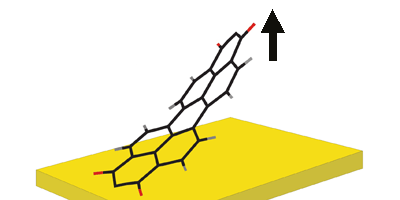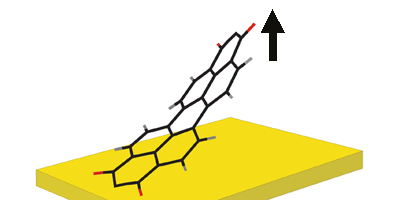A Bond Revealed
The deposition of organic molecules on metallic or semiconducting surfaces can be used to realize new molecular architectures with tailored properties, with applications in molecular recognition, catalysis, photovoltaics, and molecular electronics. The design of complex organic/inorganic interfaces depends critically on a thorough understanding of how molecules bind to a surface, which ultimately determines their orientation, conformation, and stability.
In Physical Review Letters, Christian Wagner at the Jülich Research Center, Germany, and collaborators report an investigation of the mechanisms that hold the organic molecule PTCDA, a member of a technologically relevant family of aromatic compounds, to a noble metal surface. By applying a combination of atomic force microscopy and scanning tunneling microscopy, the authors manipulate a single molecule, pull it away from the surface, and observe the breaking and re-forming of the molecule-surface bonds.
These experiments measure the forces that govern the molecule-substrate interaction and reveal the precise shape of the binding potential. The authors analyze their results to quantify three contributions to bonding: local chemical bonds between molecular oxygen atoms and the surface; bonding arising from the hybridization of delocalized molecular orbitals with substrate states; and Van der Waals forces, such as those arising from dipolar and multipolar interactions and from Pauli’s exclusion principle.
Wagner et al.’s work provides a rare experimental window on the bonding channels of large organic molecules at surfaces and may help refine density-functional-theory calculations that describe this important class of molecular systems. – Matteo Rini





